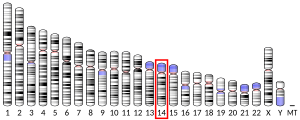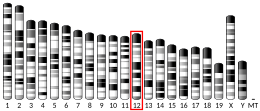c-Fos
c-Fosは、レトロウイルスのがん遺伝子v-fosのホモログであるがん原遺伝子(ヒトではFOS)にコードされるタンパク質である[5]。c-Fosはラット線維芽細胞において、FBJ MSV(Finkel–Biskis–Jinkins murine osteogenic sarcoma virus)と呼ばれるウイルスの形質転換遺伝子との類似性から発見された[6]。c-FosはFosファミリーの転写因子であり、Fosファミリーには他にFosB、Fra-1、Fra-2が含まれる[7]。c-Fosはc-Junとヘテロ二量体を形成してAP-1複合体となり、標的遺伝子のプロモーターやエンハンサー領域のAP-1特異的部位のDNAに結合することで、細胞外のシグナルを遺伝子発現の変化へと変換する[8]。c-Fosは多くの細胞機能で重要な役割を果たしており、さまざまながんで過剰発現していることが知られている。
構造と機能
[編集]c-Fosは380アミノ酸のタンパク質であり、二量体化のための塩基性ロイシンジッパー領域、C末端にDNA結合・トランス活性化ドメインを持ち、Junタンパク質と同様にホモ二量体を形成することもできる[9]。In vitroでの研究では、Jun-Fosヘテロ二量体はJun-Junホモ二量体より安定で、より強いDNA結合活性を持つことが示されている[10]。
血清、成長因子、発がんプロモーター、サイトカイン、UV照射など、さまざまな刺激がc-Fosの発現を誘導する。c-FosのmRNAとタンパク質はこうした刺激に応答して最初に発現するため、最初期遺伝子と呼ばれている。誘導は迅速かつ一過的であり、刺激後15分以内に行われる[11]。c-Fosの活性は翻訳後修飾によっても調節されており、MAPK、CDC2、PKA、PKCなどさまざまなキナーゼによってリン酸化が行われる。こうした修飾はタンパク質の安定性、DNA結合活性、転写因子のトランス活性化能に影響を与える[12][13][14]。c-Fosは遺伝子の活性化も抑制も引き起こすが、双方の過程には異なるドメインが関与していると考えられている。
c-Fosは、細胞増殖、分化、生存など重要な細胞イベントに関与している。c-Fosは低酸素や血管新生と関係する遺伝子にも関与しているため、その調節異常は発がんの重要な因子となっている[15]。また、c-Fosは細胞極性の喪失や上皮間葉転換を誘導し、乳腺上皮細胞の浸潤と転移をもたらす[16]。
臨床的意義
[編集]AP-1複合体は形質転換とがんの進行への関与が示唆されている。骨肉腫と子宮体癌では、c-Fosの過剰発現は高グレードの病変、予後の悪さと関係している。また、子宮頸部の前がん病変と浸潤性子宮頸癌との比較においては、前がん病変ではc-Fosの発現は有意に低い。c-Fosは、乳がんの生存率低下の独立した予測因子としても同定されている[17]。
コカイン、メタンフェタミン[18]、モルヒネ[19]や他の向精神薬[20][21]は、中脳皮質経路(前頭前皮質)や中脳辺縁系経路(側坐核)でc-Fosの産生を増加させ、その影響は事前の感作によって変動することが示されている[21]。
応用
[編集]c-Fosは神経の活動電位の発火の際にしばしば発現するため、c-Fosの発現は神経活動の間接的なマーカーとして利用される[22][23]。神経でのc-FosのmRNAのアップレギュレーションは、最近その神経で活動があったことを示している[24]。
c-Fosのプロモーターは薬物乱用の研究においても利用されている。このプロモーターを用いてラットの導入遺伝子をオンにし、特定の神経細胞集団を操作することで、薬物と関連した記憶や行動における役割の評価を行うことができる[25]。こうした神経細胞の制御は、オプトジェネティクスやDREADDでも再現可能である[26]。
相互作用
[編集]c-Fosは次に挙げる因子と相互作用することが示されている。
- BCL3[27]
- COBRA1[28]
- CSNK2A1[29]
- CSNK2A2[29]
- DDIT3[30]
- JUN[31][32][33][34][35][36][37]
- NCOA1[38][39]
- NCOR2[40]
- RELA[31]
- RUNX1[41][42]
- RUNX2[41][42]
- SMAD3[43]
- TBP[44]

|
出典
[編集]- ^ a b c GRCh38: Ensembl release 89: ENSG00000170345 - Ensembl, May 2017
- ^ a b c GRCm38: Ensembl release 89: ENSMUSG00000021250 - Ensembl, May 2017
- ^ Human PubMed Reference:
- ^ Mouse PubMed Reference:
- ^ Curran, T: The c-fos proto-oncogene. In: Reddy EP, Skalka AM, Curran T (eds.). The Oncogene Handbook 1988 Elsevier, New York, pp 307–327,
- ^ Curran, T.; Peters, G.; Van Beveren, C.; Teich, N. M.; Verma, I. M. (1982-11). “FBJ murine osteosarcoma virus: identification and molecular cloning of biologically active proviral DNA”. Journal of Virology 44 (2): 674–682. doi:10.1128/JVI.44.2.674-682.1982. ISSN 0022-538X. PMC 256311. PMID 6292525.
- ^ Milde-Langosch K (November 2005). “The Fos family of transcription factors and their role in tumourigenesis”. Eur. J. Cancer 41 (16): 2449–61. doi:10.1016/j.ejca.2005.08.008. PMID 16199154.
- ^ “The c-Fos protein interacts with c-Jun/AP-1 to stimulate transcription of AP-1 responsive genes”. Cell 54 (4): 541–52. (August 1988). doi:10.1016/0092-8674(88)90076-1. PMID 3135940.
- ^ “Evidence for homodimerization of the c-Fos transcription factor in live cells revealed by fluorescence microscopy and computer modeling”. Mol. Cell. Biol. 35 (21): 3785–98. (November 2015). doi:10.1128/MCB.00346-15. PMC 4589601. PMID 26303532.
- ^ “c-Jun dimerizes with itself and with c-Fos, forming complexes of different DNA binding affinities”. Cell 55 (5): 917–24. (December 1988). doi:10.1016/0092-8674(88)90147-X. PMID 3142692.
- ^ “Targeted disruption of the c-fos gene demonstrates c-fos-dependent and -independent pathways for gene expression stimulated by growth factors or oncogenes”. EMBO J. 13 (13): 3094–103. (July 1994). doi:10.1002/j.1460-2075.1994.tb06608.x. PMC 395200. PMID 8039503.
- ^ “Regulation of Fra-1 and Fra-2 phosphorylation differs during the cell cycle of fibroblasts and phosphorylation in vitro by MAP kinase affects DNA binding activity”. Oncogene 9 (9): 2537–47. (September 1994). PMID 8058317.
- ^ “Dual role for mitogen-activated protein kinase (Erk) in insulin-dependent regulation of Fra-1 (fos-related antigen-1) transcription and phosphorylation”. Biochem. J. 368 (Pt 2): 573–80. (December 2002). doi:10.1042/BJ20020579. PMC 1223008. PMID 12197835.
- ^ “Extracellular signal-regulated kinase 1/2-mediated phosphorylation of JunD and FosB is required for okadaic acid-induced activator protein 1 activation”. J. Biol. Chem. 274 (2): 1124–30. (January 1999). doi:10.1074/jbc.274.2.1124. PMID 9873060.
- ^ Tulchinsky E (July 2000). “Fos family members: regulation, structure and role in oncogenic transformation”. Histol. Histopathol. 15 (3): 921–8. PMID 10963134.
- ^ “The estrogen-dependent c-JunER protein causes a reversible loss of mammary epithelial cell polarity involving a destabilization of adherens junctions”. J. Cell Biol. 132 (6): 1115–32. (March 1996). doi:10.1083/jcb.132.6.1115. PMC 2120757. PMID 8601589.
- ^ “C-Fos expression is a molecular predictor of progression and survival in epithelial ovarian carcinoma”. Br. J. Cancer 99 (8): 1269–75. (October 2008). doi:10.1038/sj.bjc.6604650. PMC 2570515. PMID 18854825.
- ^ “Amphetamine and cocaine induce drug-specific activation of the c-fos gene in striosome-matrix compartments and limbic subdivisions of the striatum”. Proc. Natl. Acad. Sci. U.S.A. 87 (17): 6912–6. (September 1990). Bibcode: 1990PNAS...87.6912G. doi:10.1073/pnas.87.17.6912. PMC 54648. PMID 2118661.
- ^ “Psychomotor stimulant- and opiate-induced c-fos mRNA expression patterns in the rat forebrain: comparisons between acute drug treatment and a drug challenge in sensitized animals”. Neurochem. Res. 21 (11): 1425–35. (November 1996). doi:10.1007/BF02532384. PMID 8947933.
- ^ “A single dose of lysergic acid diethylamide influences gene expression patterns within the mammalian brain”. Neuropsychopharmacology 26 (5): 634–42. (May 2002). doi:10.1016/S0893-133X(01)00405-5. PMID 11927188.
- ^ a b “Induction of c-Fos expression in specific areas of the fear circuitry in rat forebrain by anxiogenic drugs”. Biol. Psychiatry 53 (4): 275–83. (February 2003). doi:10.1016/S0006-3223(02)01574-3. PMID 12586446.
- ^ “Environmental novelty is associated with a selective increase in c-fos expression in the output elements of the hippocampal formation and the perirhinal cortex”. Learn. Mem. 15 (12): 899–908. (2008). doi:10.1101/lm.1196508. PMC 2632843. PMID 19050162.
- ^ “The use of c-fos as a metabolic marker in neuronal pathway tracing”. Journal of Neuroscience Methods 29 (3): 261–265. (1989). doi:10.1016/0165-0270(89)90150-7. PMID 2507830.
- ^ “Conditioned Fear Inhibits c-fos mRNA Expression in the Central Extended Amygdala”. Brain Res. 1229: 137–46. (September 2008). doi:10.1016/j.brainres.2008.06.085. PMC 2605076. PMID 18634767.
- ^ “Targeted disruption of cocaine-activated nucleus accumbens neurons prevents context-specific sensitization”. Nat. Neurosci. 12 (8): 1069–73. (August 2009). doi:10.1038/nn.2364. PMC 2752202. PMID 19620976.
- ^ Garner, Aleena (March 2012). “Generation of a Synthetic Memory Trace”. Science 335 (6075): 1513–1516. Bibcode: 2012Sci...335.1513G. doi:10.1126/science.1214985. PMC 3956300. PMID 22442487.
- ^ “Bcl3, an IkappaB protein, stimulates activating protein-1 transactivation and cellular proliferation”. J. Biol. Chem. 274 (40): 28491–6. (October 1999). doi:10.1074/jbc.274.40.28491. PMID 10497212.
- ^ “COBRA1 inhibits AP-1 transcriptional activity in transfected cells”. Biochem. Biophys. Res. Commun. 325 (2): 568–73. (December 2004). doi:10.1016/j.bbrc.2004.10.079. PMID 15530430.
- ^ a b “Casein kinase II interacts with the bZIP domains of several transcription factors”. Nucleic Acids Res. 26 (16): 3854–61. (August 1998). doi:10.1093/nar/26.16.3854. PMC 147779. PMID 9685505.
- ^ “CHOP enhancement of gene transcription by interactions with Jun/Fos AP-1 complex proteins”. Mol. Cell. Biol. 19 (11): 7589–99. (November 1999). doi:10.1128/MCB.19.11.7589. PMC 84780. PMID 10523647.
- ^ a b “ERK MAP kinase links cytokine signals to activation of latent HIV-1 infection by stimulating a cooperative interaction of AP-1 and NF-kappaB”. J. Biol. Chem. 274 (39): 27981–8. (September 1999). doi:10.1074/jbc.274.39.27981. PMID 10488148.
- ^ “Identification of SWI.SNF complex subunit BAF60a as a determinant of the transactivation potential of Fos/Jun dimers”. J. Biol. Chem. 276 (4): 2852–7. (January 2001). doi:10.1074/jbc.M009633200. PMID 11053448.
- ^ “Cross-family interaction between the bHLHZip USF and bZip Fra1 proteins results in down-regulation of AP1 activity”. Oncogene 14 (17): 2091–8. (May 1997). doi:10.1038/sj.onc.1201046. PMID 9160889.
- ^ “Crystal structure of the heterodimeric bZIP transcription factor c-Fos-c-Jun bound to DNA”. Nature 373 (6511): 257–61. (January 1995). Bibcode: 1995Natur.373..257G. doi:10.1038/373257a0. PMID 7816143.
- ^ “Isolation and characterization of a novel member of the gene family encoding the cAMP response element-binding protein CRE-BP1”. J. Biol. Chem. 268 (6): 4259–66. (February 1993). PMID 8440710.
- ^ “Detection and modulation in vivo of helix-loop-helix protein-protein interactions”. J. Biol. Chem. 268 (1): 5–8. (January 1993). PMID 8380166.
- ^ “Nrf2 and Nrf1 in association with Jun proteins regulate antioxidant response element-mediated expression and coordinated induction of genes encoding detoxifying enzymes”. Oncogene 17 (24): 3145–56. (December 1998). doi:10.1038/sj.onc.1202237. PMID 9872330.
- ^ “Activating protein-1, nuclear factor-kappaB, and serum response factor as novel target molecules of the cancer-amplified transcription coactivator ASC-2”. Mol. Endocrinol. 14 (6): 915–25. (June 2000). doi:10.1210/mend.14.6.0471. PMID 10847592.
- ^ “Steroid receptor coactivator-1 coactivates activating protein-1-mediated transactivations through interaction with the c-Jun and c-Fos subunits”. J. Biol. Chem. 273 (27): 16651–4. (July 1998). doi:10.1074/jbc.273.27.16651. PMID 9642216.
- ^ “Silencing mediator of retinoic acid and thyroid hormone receptors, as a novel transcriptional corepressor molecule of activating protein-1, nuclear factor-kappaB, and serum response factor”. J. Biol. Chem. 275 (17): 12470–4. (April 2000). doi:10.1074/jbc.275.17.12470. PMID 10777532.
- ^ a b “AP-1 and Cbfa/runt physically interact and regulate parathyroid hormone-dependent MMP13 expression in osteoblasts through a new osteoblast-specific element 2/AP-1 composite element”. J. Biol. Chem. 276 (23): 20029–38. (June 2001). doi:10.1074/jbc.M010601200. PMID 11274169.
- ^ a b “Physical interaction of the activator protein-1 factors c-Fos and c-Jun with Cbfa1 for collagenase-3 promoter activation”. J. Biol. Chem. 277 (1): 816–22. (January 2002). doi:10.1074/jbc.M107082200. PMID 11641401.
- ^ “Smad3 and Smad4 cooperate with c-Jun/c-Fos to mediate TGF-beta-induced transcription”. Nature 394 (6696): 909–13. (August 1998). Bibcode: 1998Natur.394..909Z. doi:10.1038/29814. PMID 9732876.
- ^ “c-Fos-induced activation of a TATA-box-containing promoter involves direct contact with TATA-box-binding protein”. Mol. Cell. Biol. 14 (9): 6021–9. (September 1994). doi:10.1128/MCB.14.9.6021. PMC 359128. PMID 8065335.
関連文献
[編集]- “Regulation of gene expression in T-47D human breast cancer cells by progestins and antiprogestins”. Hum. Reprod. 9 Suppl 1: 174–80. (June 1994). doi:10.1093/humrep/9.suppl_1.174. PMID 7962462.
- “c-Fos expression during wakefulness and sleep”. Neurophysiol Clin 25 (6): 329–41. (1995). doi:10.1016/0987-7053(96)84906-9. PMID 8904195.
- “Activation of c-fos in the brain”. Prog. Neurobiol. 50 (2–3): 83–107. (October 1996). doi:10.1016/S0301-0082(96)00021-4. PMID 8971979.
- “[Possible role of transcription factor AP1 in the tissue-specific regulation of human papillomavirus]” (スペイン語). Rev. Invest. Clin. 54 (3): 231–42. (2002). PMID 12183893.
関連項目
[編集]外部リンク
[編集]- c-fos Proteins - MeSH・アメリカ国立医学図書館・生命科学用語シソーラス
- c-fos Genes - MeSH・アメリカ国立医学図書館・生命科学用語シソーラス
- FactorBook c-Fos
- Drosophila kayak - The Interactive Fly
- Human FOS genome location and FOS gene details page in the UCSC Genome Browser.
- Overview of all the structural information available in the PDB for UniProt: P01100 (Human Proto-oncogene c-Fos) at the PDBe-KB.
- Overview of all the structural information available in the PDB for UniProt: P01101 (Mouse Proto-oncogene c-Fos) at the PDBe-KB.





